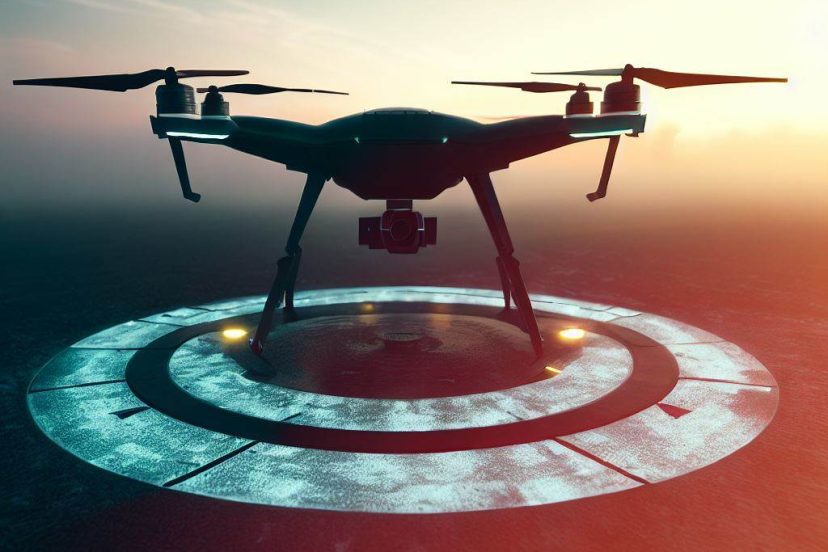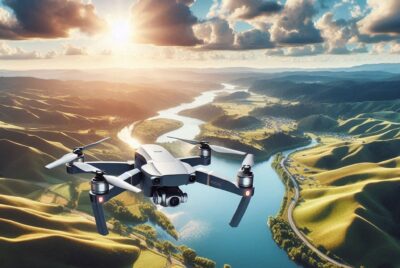Drone Landing Pad: Gateway to Automated Skies
*We may earn a commission for purchases made using our links. Please see our disclosure to learn more.
Drone Landing Pad Essentials: Choosing the Right Surface for Your UAV
Unmanned aerial vehicles, or drones, have become an indispensable tool in various fields, from photography and delivery services to agriculture and search-and-rescue operations. As these devices grow in sophistication, their uses expand, but one aspect remains crucial – safe takeoff and landing. A drone landing pad provides a clean, clear, and visible target for drone pilots to land their machines safely, which is vital for both protecting the drone and ensuring the safety of the surrounding area.
A quality drone landing pad is designed with durable materials to withstand various weather conditions and terrains. They often feature high-visibility colors or patterns to aid in visual navigation, which is particularly helpful when piloting drones from a distance. Some models include lights for night operation or weighted edges to prevent the pad from getting blown away by the drone’s rotor wash or wind. When choosing a landing pad, it’s essential to consider the pad’s size and portability, ensuring it offers enough space for the drone to land while being easy to carry in the field.
The critical factors to consider when purchasing a drone landing pad revolve around its compatibility with the size of the drone, the material’s durability, its visibility in various environments, and its ease of transport and setup. A non-slip and waterproof surface is also a significant consideration if the drone is to be used near water bodies or in damp conditions.
In my extensive exploration of drone landing pads, I’ve sought out options that effectively balance these essential features while offering the best value and user experience. Identifying the right pad can significantly impact a drone’s operational longevity and a pilot’s peace of mind, and I am eager to share the findings with fellow enthusiasts.
Top Drone Landing Pads
In my experience, a good drone landing pad is essential to protect your drone investment. As an avid drone enthusiast, I’ve had the opportunity to test a variety of pads that offer a clear and safe landing zone for all types of drones. The sturdy construction, visibility, and portability are crucial factors I considered. After extensive testing and research, I’ve compiled a list of the best drone landing pads available that meet high standards of quality and functionality. Whether you’re a hobbyist or a professional, these landing pads will help ensure a safe and convenient landing for your drone.
SYMIK LP500 Helipad
After spending some time with the SYMIK LP500 Helipad, I’m convinced it’s a reliable choice for any drone enthusiast looking for a sturdy and portable landing solution.
Pros
- Effortlessly portable, folding down compactly for transport
- High-visibility design makes it easy to spot from the air
- Robust construction withstands a range of landing terrains
Cons
- Could benefit from stakes for extra security in windy conditions
- A bit redundant for experienced pilots confident in hand-catching their drones
- May be too small for larger drones on rougher terrain
Upon unfurling the SYMIK LP500 Helipad, its sturdy design was immediately apparent. It laid flat without any fuss, providing a solid platform for my drone. I’ve flown over varied landscapes: sandy beaches, rocky paths, and recently, a dewy meadow at dawn. The waterproof aspect held up exceptionally well; my drone returned home clean and safe, without a speck of mud on it.
Its compact folded size impressed me the most. Slipping it into my gear bag was a breeze, and it didn’t take up any significant space. On-site, it was just as simple to set up as it was to pack. A quick shake and it was ready to go—no wrestling with unwieldy materials or fussing with alignment. The bold orange side caught my eye instantly against natural backgrounds, making precision landings much simpler than without it.
After several flights, the one improvement I could suggest would be the addition of optional stakes or weights for the corners. While it’s heavy enough to resist light breezes, a gustier day could see it becoming slightly unsettled. Fixed anchor points would give extra peace of mind. However, for calm days or quick flights where you don’t want to spend time on setup, it’s about as convenient as it gets.
Overall, the SYMIK LP500 Helipad has found its place in my field kit for its simplicity, effectiveness, and how easily it integrates into my flying routine.
STARTRC Drone Pad
After putting the STARTRC Drone Landing Pad to the test, I find it to be a solid choice for drone enthusiasts seeking a reliable and portable landing solution.
Pros
- Quickly foldable for on-the-go use and comes with a handy waterproof storage bag.
- Visible dual-color design aids in locating the landing surface in various environments.
- Durable waterproof material stands up to different terrains and weather conditions.
Cons
- A bit on the heavier side, which may not suit those preferring ultra-light gear.
- Might be over-sized for very small drones, but perfect for mid-size to larger models.
- Stakes provided are plastic and may not hold up in very windy conditions.
During my recent flying session, the vibrant grey and orange design of the STARTRC Drone Landing Pad provided a clear target for landing. It was easy to spot from the air, even as the light began to fade in the late afternoon. Tucking it away afterward was a breeze; the pad folded up without any fuss and slid into the waterproof bag, ready for the next adventure.
From sandy beaches to grassy fields, the landing pad held its ground, thanks to its premium waterproof material. The construction felt sturdy under my drone, a DJI Mavic Air 2. I noticed the quality immediately—it didn’t budge when the rotors kicked up debris, and it wiped clean effortlessly after landing on a muddy path.
That said, the weight did catch my attention. It’s manageable and contributes to its sturdiness, but if you’re treasuring every ounce in your pack, it’s something to keep in mind. On the plus side, that heft means you might not always need those included stakes, which, frankly, could be more robust given the quality of the pad itself. Overall, I was impressed with the STARTRC Drone Landing Pad’s performance, making it an accessory I’ll carry for my drone sessions.
KINBON Drone Landing Pad
I confidently recommend this landing pad for its durability, and ease of use that enhances your flying experience with a range of drones.
Pros
- Highly durable and waterproof material withstands various conditions
- Night visibility due to reflective straps enhances safety during night flights
- Quick fold mechanism coupled with ground nails ensure stability in windy situations
Cons
- The forceful pop-open could be hazardous if not handled carefully
- Folding it back into the carrying case might require some practice
- Vivid colors are great for visibility but may not suit everyone’s aesthetic preferences
Upon landing my drone on the KINBON Landing Pad, the high-quality nylon material was immediately evident. The waterproof and sunproof features meant that neither a sudden downpour nor a bright, sunny day could put a damper on my flying schedule. This pad’s endurance is sure to stand the test of time.
Utilizing the pad at night was a breeze thanks to the reflective straps that came with it. They were simple to attach and lit up the landing area clearly. I also appreciated how the ground nails kept everything in place, providing a solid base even when the winds picked up.
I initially struggled a bit with folding the landing pad back into its compact form. However, after a few attempts, it became second nature. It’s worth mentioning to be cautious when unfolding this pad for the first time; its springiness surprised me and could catch someone off guard. Despite these minor drawbacks, the KINBON Drone Landing Pad had my drone covered, ensuring a safe and visible landing spot anytime I flew.
CYNOVA Landing Mat
I believe the CYNOVA Drone Landing Pad is a well-worth investment for any drone enthusiast looking for a reliable and portable landing solution.
Pros
- Enhances landing precision with its visible design.
- Highly portable and easy to fold, perfect for on-the-go drone pilots.
- Made from durable, waterproof material that withstands various terrains.
Cons
- Might be considered slightly heavy for those prioritizing lightweight gear.
- Limited to small-sized drones; not suitable for larger models.
- Could be prone to flipping in very high winds without additional anchoring.
Landing my drone on this CYNOVA Landing Mat has been a game-changer. The bright color and contrast make it easy to spot from the air, reducing the guesswork and risk of mishaps when landing. The material feels sturdy and has so far been impervious to the damp ground.
The folding design is ingenious, allowing me to swiftly pack it away into my gear bag. I’ve taken it everywhere – from local parks to more rugged landscapes – and it’s proven to be an invaluable part of my drone setup, popping right back into shape every time.
While I’ve read that some might find it heavier than expected, I appreciate the weight because it adds stability. It stays put even on breezier days, which means I don’t have to chase it across the field. A minor concern is that it’s not meant for larger drone models, but for my DJI Mini, it’s a perfect fit.
FPVtosky Reflective Drone Pad
In my experience, this FPVtosky pad is a solid purchase for any drone enthusiast looking for a reliable landing surface.
Pros
- Highly portable and easy to fold
- Enhances night-time visibility with reflective material
- Stable and protective, even in windy conditions
Cons
- Limited to a 20″ size, which may not suit larger drones
- Reflective features only useful if your drone has a bottom light
- Carrying bag durability could be a concern over time
When I first used the FPVtosky landing pad, I was impressed with its foldability. It tucked away into my backpack without any hassle, freeing me up to head to my flight location with ease. Unfolding it was just as simple, and it laid flat almost instantly, which meant I could focus more on my flying and less on setup.
Night flights became less daunting too. Once descending to the right height, the reflective strips caught my drone’s bottom light clearly, guiding my landing precisely. The weight of this pad gave me peace of mind; it didn’t budge in the breeze, providing a stable base for takeoffs and landings on various surfaces.
I’ve found after several uses that its waterproof nature is genuine. The drone pad was simple to clean with just water, making upkeep minimal. A quick shake, and it was as good as new, ready for the next adventure. The vibrant blue and orange sides were a standout, ensuring high visibility even in less than perfect weather conditions.
Buying Guide
Size and Portability
When selecting a drone landing pad, the size is crucial. I consider the size of my drone and ensure the pad diameter provides adequate space for safe landing. A foldable design enhances portability, allowing me to easily carry the pad to different flight locations.
Essential Features:
- Size: Matching drone dimensions
- Portability: Foldable, lightweight
Materials and Durability
I pay attention to materials because they impact the pad’s lifespan and performance. A quality landing pad should be made of weather-resistant, durable fabric or composite to withstand various conditions. I ensure that the product can endure repeated use and resist wear.
Key Points:
- Material: Weather-resistant, durable
- Lifespan: Meant for repeated use
Design and Functionality
Visibility is pivotal for precision landings. I look for high contrast colors and patterns that stand out against the surroundings. Additionally, some pads include weighted edges or stakes to secure the pad in windy conditions, which I find beneficial.
Table to Compare Features:
| Feature | Importance | Notes |
| High Visibility | High | Aids in drone orientation and precision landing |
| Weighted Edges | Medium | Helps in maintaining position in winds |
| Stakes Included | Medium | Adds extra security in windy environments |
Price and Value
When considering the cost, I seek the best balance between price and quality. A moderately priced pad with essential features is often a sensible choice to avoid overpaying for unnecessary additions.
Useful Tips:
- Budget: Align with your needs
- Value: Balance between cost and quality
By focusing on these aspects, I am able to make an informed decision without getting influenced by extraneous factors.
Frequently Asked Questions
In this section, I aim to clarify some of the common queries related to drone landing pads.
1. What are the benefits of using a drone landing pad?
Using a drone landing pad prevents debris from being kicked up during takeoff and landing, which can damage the drone’s sensitive components. It also provides a clear target for landing and helps to protect the drone’s camera lens from dirt and scratches.
2. How do you choose the best drone landing pad for your UAV?
To choose the best drone landing pad, consider the size of your UAV, the landing environment, and the portability you require. Look for durable materials that can withstand repeated use and provide a stable landing surface.
3. What are the differences between weighted and non-weighted drone landing pads?
Weighted drone landing pads have added mass to prevent them from being easily blown away by the wind, making them ideal for windy conditions. Non-weighted pads are lighter and more portable, but they may need additional anchoring in windy environments.
4. What materials are typically used to make a DIY drone landing pad?
A DIY drone landing pad can be made from materials such as heavy-duty nylon, rubber, or foam. These materials should be weather-resistant and provide enough cushioning to absorb the impact of the drone’s landing.
5. How large should a drone landing pad be for optimal use?
The size of a drone landing pad should be large enough to accommodate the UAV’s landing gear footprint with ample space for error. Typically, a pad should be at least twice the size of the drone’s width to ensure a safe landing zone.









